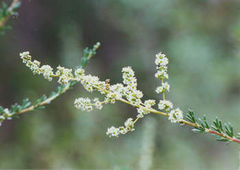Adenostoma
| Standard Cyclopedia of Horticulture |
|---|
|
Adenostoma (aden, gland, sloma, mouth; calyx with five glands at the mouth). Rosaceae. Ornamental woody plants, cultivated chiefly for their handsome white flowers. Evergreen, somewhat resinous shrubs, rarely small trees: lvs. linear, small: fls. white, about 1-5 in. broad, in terminal panicles; calyx-tube obconical, with 5 short teeth and 5 glands at the mouth; petals 5, stamens 10-15; pistil 1, with the lateral style strongly curved above the base: fr. a small achene, inclosed in the persistent calyx-tube.—Two species in Calif. The adenostomas are heath-like evergreen shrubs; very handsome when in full bloom. They may be cult. in temperate regions in a sunny position and well- drained soil. A. fasciculatum stands many degrees of frost. Prop, is by seeds and greenwood cuttings in spring.
The above text is from the Standard Cyclopedia of Horticulture. It may be out of date, but still contains valuable and interesting information which can be incorporated into the remainder of the article. Click on "Collapse" in the header to hide this text. |
| Adenostoma {{{status}}} Fossil range: {{{fossil_range}}}
| ||||||||||||||||||||||||||||||||||||||||||||||||||||||||||||||||||
|---|---|---|---|---|---|---|---|---|---|---|---|---|---|---|---|---|---|---|---|---|---|---|---|---|---|---|---|---|---|---|---|---|---|---|---|---|---|---|---|---|---|---|---|---|---|---|---|---|---|---|---|---|---|---|---|---|---|---|---|---|---|---|---|---|---|---|
 Adenostema fasciculatum | ||||||||||||||||||||||||||||||||||||||||||||||||||||||||||||||||||
| Plant Info | ||||||||||||||||||||||||||||||||||||||||||||||||||||||||||||||||||
| ||||||||||||||||||||||||||||||||||||||||||||||||||||||||||||||||||
| Scientific classification | ||||||||||||||||||||||||||||||||||||||||||||||||||||||||||||||||||
| ||||||||||||||||||||||||||||||||||||||||||||||||||||||||||||||||||
| [[{{{diversity_link}}}|Diversity]] | ||||||||||||||||||||||||||||||||||||||||||||||||||||||||||||||||||
| {{{diversity}}} | ||||||||||||||||||||||||||||||||||||||||||||||||||||||||||||||||||
| Binomial name | ||||||||||||||||||||||||||||||||||||||||||||||||||||||||||||||||||
| {{{binomial}}} | ||||||||||||||||||||||||||||||||||||||||||||||||||||||||||||||||||
| Trinomial name | ||||||||||||||||||||||||||||||||||||||||||||||||||||||||||||||||||
| {{{trinomial}}} | ||||||||||||||||||||||||||||||||||||||||||||||||||||||||||||||||||
| Type Species | ||||||||||||||||||||||||||||||||||||||||||||||||||||||||||||||||||
| {{{type_species}}} | ||||||||||||||||||||||||||||||||||||||||||||||||||||||||||||||||||
| {{{subdivision_ranks}}} | ||||||||||||||||||||||||||||||||||||||||||||||||||||||||||||||||||
| [[Image:{{{range_map}}}|{{{range_map_width}}}|]] | ||||||||||||||||||||||||||||||||||||||||||||||||||||||||||||||||||
| Synonyms | ||||||||||||||||||||||||||||||||||||||||||||||||||||||||||||||||||
| {{{synonyms}}} |
Adenostoma is a genus of shrubs containing only two species: Adenostoma fasciculatum (Commonly known as Chamise), and Adenostoma sparsifolium (Red shank). Both are native to coastal California and Baja California, while A. fasciculatum is also native to California's Sierra Nevada mountains.[1]
Both species in this genus feature stiff, linear leaves arranged alternately or in clusters along stems with shredding bark. Flowers form on a panicle, are cream to white and, as in all members of the rose family, are hypanthiums.[1]